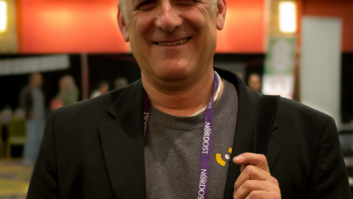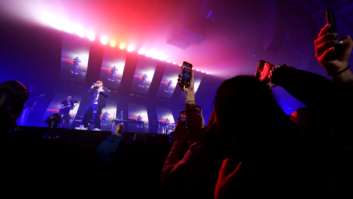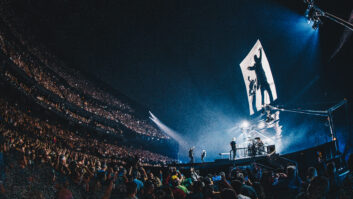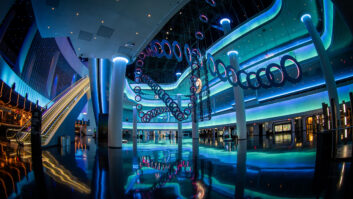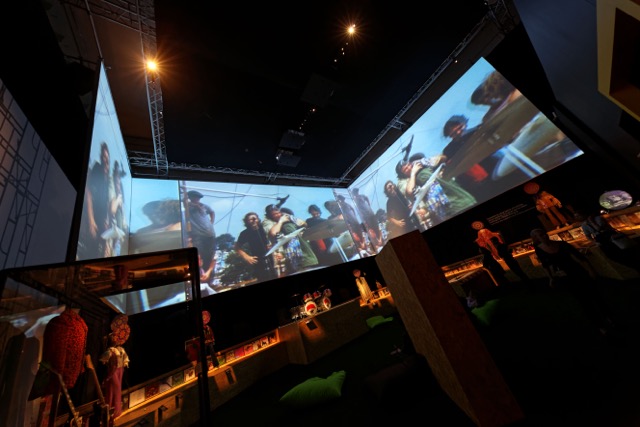
The late Sixties saw great upheavals in numerous aspects of society – and music played a central role in articulating the mood of the times. Paddy Baker donned bell-bottoms and tie-dye shirt to visit a new exhibition that brings this era back to life.
The latest exhibition at London’s Victoria & Albert Museum looks at the huge, multifaceted societal changes that took place at the end of the Sixties – and helped to shape the world of today. You Say You Want a Revolution? Records and Rebels 1966-1970 consists of six galleries, each dedicated to a different environment where these changes took place: fashion, youth culture and identity; clubs and counterculture; political revolution and street protests; the rise of consumerism; festivals and gatherings; and the alternative communities on the west coast of the USA, and their interplay with the rise of modern computing.
Music plays an important part in the exhibition, just as it did in giving voice to many of the new ideas that were in circulation in the Sixties, and playing a major role in the developing culture. With this musical connection, it’s not surprising that the event has a number of similarities with the V&A’s David Bowie Is exhibition of 2013: it has the same curators – Geoffrey Marsh and Victoria Broackes; it features a musical backdrop delivered by Sennheiser, the brainchild of system designer Norbert Hilbich; and the AV integration was carried out by Sysco AV.
“Music was the key form of communication in the period, and it’s at the heart of the exhibition, with a soundtrack guiding you through the space,” says Broackes.
As in the Bowie exhibition, Sennheiser’s guidePORT technology is used to create an immersive environment, delivering music and audio to visitors. When a visitor’s bodypack comes within range of a guidePORT identifier, audio relevant to that area starts playing in their headphones – streamed wirelessly from media players via guidePORT cell transmitters and antennas.
There’s a difference, though. In the Bowie show, guidePORT was mainly used to play audio that was synced to videos that were playing. Here, while there are a handful of videos for which guidePORT provides synced music, for the most part music is used to provide extra context to the visuals, be they videos or artefacts.
“It’s an additional layer – even if you’re not listening to every word of the lyrics, it’s giving you a sense of what you might have been hearing if you had been there,” says Elisa Bailey, curatorial assistant. “For example, a lot the people that we spoke to for this exhibition had recollections of the Beatles’ Sergeant Pepper album being the backing track to everything they were doing – walking down the Kings Road or Carnaby Street, it would be blaring out of the boutiques, or being played as the Monterey Festival was being built.”
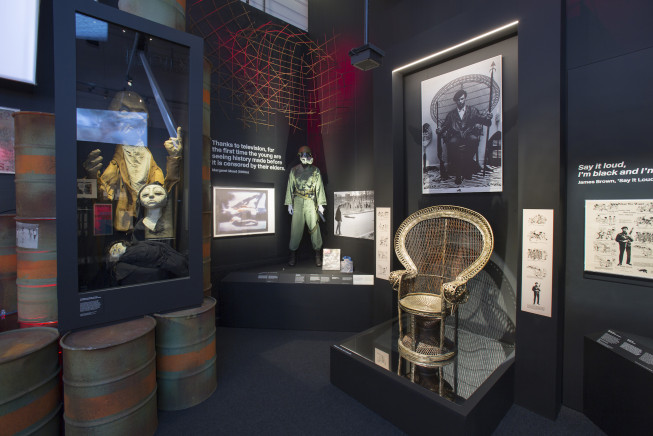
Authentic crackle
Music used in the exhibition has been taken as far as possible from original LPs, sometimes with authentic crackle – “so they sound like they sounded at that time”, comments Robert Genereux, business director for system design, who project-managed Sennheiser’s contribution to the exhibition and was closely involved with the guidePORT installation.
Each room has its own separate soundtrack, so as you move from one room to another, the music gently fades away, before the next soundtrack fades in. “The music playlists are long, so if someone comes back, they’ll most likely have a completely different experience,” says Genereux.
The exhibition uses just as many guidePORT trigger points as the Bowie show, even though there are fewer music cues. “Because the spaces are bigger, sometimes we need three points that trigger the same thing. So this show is as complicated as the previous one for us,” he points out.
As the team discovered during the set-up of the Bowie show, the wooden floor tiles in the exhibition space have metal underneath them, “so we cannot use the floor to create zones”. Instead, guidePORT identifiers are used – some in plain sight, some hidden away.
Genereux is full of praise for Sysco’s role in the installation. “They did a great job – we had great people and it went really, really well.”
Additionally, there is background audio playing in most of the rooms, created by sound designer Carolyn Downing from ‘found sounds’ from sources such as film soundtracks; for instance, a 1960s Roberts radio plays songs that appear in the iconic 1966 film Blow-Up; elsewhere, the sound of a cow mooing, taken from the Woodstock soundtrack, helps conjure up the atmosphere of Yasgur’s Farm, where the legendary festival was staged.
Immersive upmixes
The exhibition features two Sennheiser immersive audio installations – using a set of technologies that it now markets under the AMBEO name. Woodstock features in one of these, where songs taken from the film soundtrack have been upmixed to 14.1. “Actually it’s a 14.0 system,” says Sennheiser international recording application manager Gregor Zielinsky, “although we’re using five subwoofers. We’re using bass management – rather than having a separate LFE channel, we are taking everything below 80Hz and sending it through the subwoofers.”
The main speakers are positioned on two levels to bring a vertical element to the immersion. There is no overhead ‘voice of God’ channel; as Zielinsky explains, this is more appropriate for applications such as films with aeroplanes passing overhead than for recreations of outdoor concerts.
The festivals room also houses the show’s largest visual installation – four Epson projectors that beam 6m-high images over three walls.
The other AMBEO environment is an 8.1 set-up in the third room, which explores civil unrest and protest.
CEO Daniel Sennheiser believes that, for the listener, making the move to immersive audio “is as revolutionary as going from mono to stereo”. The technology has wide applications: not just in live and recorded music, but also in sports broadcasts – where listeners can pick their listening position in the stadium and the commentator they want to listen to – and cinemas. He also believes that the technology will soon become widespread: “Not tomorrow, but in five to ten years’ time – especially with the rise of virtual reality and augmented reality, that need is there; we’re going to become more accustomed to immersive audio formats. It will take some time, but once the step up is made, there’s no way back.” Now there’s another revolution for you.
Pictures: Victoria and Albert Museum
www.merging.com
www.neumann.com
www.sennheiser.com
www.syscoav.co.uk
www.vam.ac.uk


